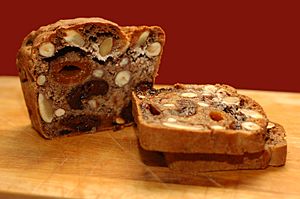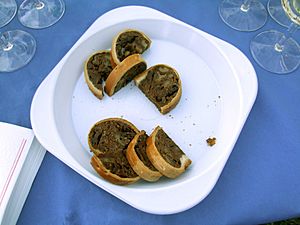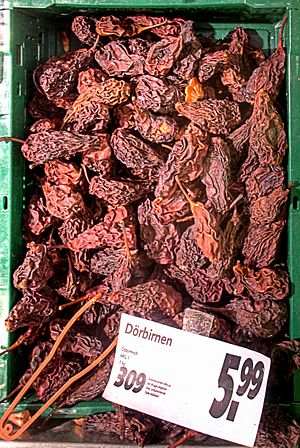Früchtebrot facts for kids
Früchtebrot is a yummy, dark, and sweet bread made with lots of dried fruit. You might also hear it called Birnenbrot or Kletzenbrot in different places.
This special bread is usually baked in small, long loaves. It feels juicy and firm, and you can see all the colorful pieces of fruit and nuts inside. Often, it has almonds and bright red maraschino cherries. One cool thing about Früchtebrot is that it stays fresh for a long time!
Contents
Where Does Früchtebrot Come From?
Früchtebrot is very popular in southern Germany, Austria, and parts of Italy like South Tyrol and Trentino. People often make it during the Advent season, which is the time leading up to Christmas.
Originally, this bread was mostly made with dried pears. In some areas, these dried pears are called Kletzen, which is why the bread is sometimes known as Kletzenbrot. Over time, as people could get more kinds of fruit, Früchtebrot started to include other delicious dried fruits like plums, raisins, apricots, dates, figs, oranges, and lemons.
Long ago, Früchtebrot got its sweetness only from the dried pears. It didn't have extra honey or sugar. Also, it was usually made with a darker dough, not wheat dough. Using wheat dough can make the bread look less traditional and might cause the fruits to get too dark when baking.
Christmas Traditions with Birnenbrot
In a region called upper Allgäu, where people were once quite poor, Birnenbrot was a special treat eaten on Christmas Eve. Sometimes, children from poor families would sing Christmas songs outside farmhouses. As a thank you, they would receive Birnenbrot.
In the city of Bolzano, a type of Früchtebrot called Bozner Zelten has been a Christmas tradition since the Middle Ages!
How Früchtebrot Was Used
Baking Früchtebrot often started around Saint Andrew's Day on November 30. On the night of Saint Andrew's Day, young men wearing masks would ask for gifts, and Früchtebrot was one of them.
It was also a festive food eaten on Saint Nicholas's Day.
Sharing at Christmas
On Christmas Eve and Boxing Day, the father of the family would slice the Früchtebrot and share it. Everyone in the family, including children, farmworkers, and maids, would get a piece. People even gave Früchtebrot to their farm animals, hoping it would bring good luck to the stables!
An Old Engagement Custom
There was an old tradition involving Früchtebrot and engagements. Young women who were old enough to marry would give the ends of the Früchtebrot loaves to their boyfriends. If the edges were cut smoothly, it meant they liked the person. If the edges were cut roughly, it was a way to end the relationship!
Früchtebrot in Stories
Früchtebrot has even appeared in books!
- The German writer Eduard Mörike wrote a story called "Stuttgarter Hutzelmännlein". In the story, a magical little man gives a shoemaker named Seppe a loaf of Früchtebrot for his journey.
- Thomas Mann mentions Früchtebrot in his famous book The Magic Mountain. He describes it as a special treat served at a sanatorium (a type of health resort) in Switzerland.
- Many children might know about fruit bread from the popular children's book The Very Hungry Caterpillar, where the caterpillar eats through a slice of plum cake, which is similar to a fruit bread!
See also
 In Spanish: Beerawecka para niños
In Spanish: Beerawecka para niños




